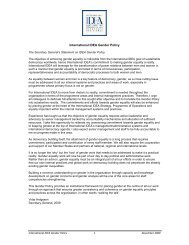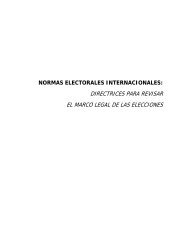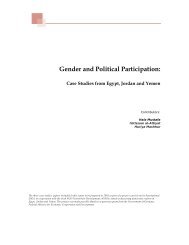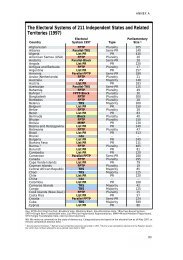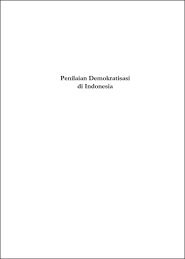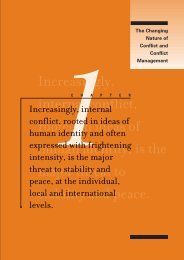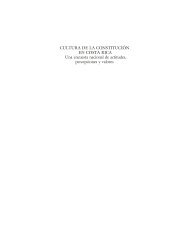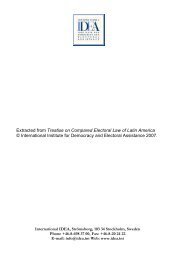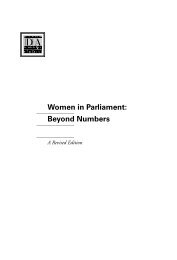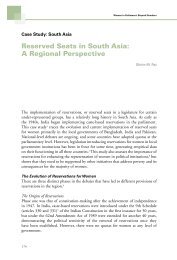The Role of State Constitutions in Protecting ... - International IDEA
The Role of State Constitutions in Protecting ... - International IDEA
The Role of State Constitutions in Protecting ... - International IDEA
Create successful ePaper yourself
Turn your PDF publications into a flip-book with our unique Google optimized e-Paper software.
federation, and <strong>of</strong> the accommodations that <strong>in</strong> this case were made to resolve<br />
them. Another po<strong>in</strong>t may be <strong>of</strong> <strong>in</strong>terest as well: while the particular compromises<br />
served to achieve federation, none worked out precisely as expected. <strong>The</strong> Senate<br />
votes on political party l<strong>in</strong>es. It has done relatively little to protect <strong>State</strong> <strong>in</strong>terests,<br />
beyond <strong>in</strong>creas<strong>in</strong>g the representation <strong>of</strong> the smaller <strong>State</strong>s <strong>in</strong> the Commonwealth<br />
Parliament well beyond that to which they would otherwise have been entitled.<br />
Neither <strong>of</strong> the two alternatives for revenue redistribution over which the framers<br />
<strong>of</strong> the Constitution fought were serious contenders for long. Rather, revenue<br />
redistribution now occurs on the basis <strong>of</strong> the pr<strong>in</strong>ciples <strong>of</strong> fiscal equalization,<br />
through a system <strong>in</strong> which the population <strong>of</strong> each <strong>State</strong> is weighted by a factor<br />
that takes <strong>in</strong>to account <strong>State</strong> revenue rais<strong>in</strong>g abilities and expenditure needs. <strong>The</strong><br />
Commonwealth Constitution has proved very difficult to change and, <strong>in</strong> most<br />
cases, even national majorities reject referendum proposals. Predictably, appeals to<br />
the Privy Council became irrelevant, with Australian <strong>in</strong>dependence. Arguably,<br />
however, the focus on the Privy Council prevented the <strong>State</strong>s from perceiv<strong>in</strong>g how<br />
important the High Court would become, <strong>in</strong> <strong>in</strong>terpret<strong>in</strong>g the Constitution and<br />
from recogniz<strong>in</strong>g the potential significance <strong>of</strong> the fact that the Commonwealth<br />
government alone would appo<strong>in</strong>t that Court.<br />
<strong>State</strong> <strong>Constitutions</strong><br />
<strong>The</strong> constituent parts <strong>of</strong> the Australian federation are the six orig<strong>in</strong>al <strong>State</strong>s.<br />
Australia also has some territories, some <strong>of</strong> which are “self-govern<strong>in</strong>g” but which<br />
lack the constitutional autonomy <strong>of</strong> the <strong>State</strong>s. One <strong>of</strong> these, the Northern<br />
Territory aspires to become a <strong>State</strong>. <strong>The</strong> potential relevance <strong>of</strong> this for <strong>in</strong>digenous<br />
Australians will be considered <strong>in</strong> that context, below.<br />
Each <strong>of</strong> the Australian <strong>State</strong>s has its own Constitution. Each <strong>State</strong> Constitution<br />
dates back to the colonial period. Each was drafted by the <strong>State</strong> (then colonial)<br />
Parliament, rely<strong>in</strong>g on authority granted by the British Parliament. <strong>The</strong> <strong>State</strong><br />
<strong>Constitutions</strong> are broadly similar, because they derived from the same colonial<br />
model. <strong>The</strong>y are not identical, however and they have become <strong>in</strong>creas<strong>in</strong>gly<br />
dissimilar over time, as changes have occurred.<br />
<strong>The</strong> ma<strong>in</strong> purpose <strong>of</strong> each <strong>State</strong> Constitution is to establish the govern<strong>in</strong>g<br />
<strong>in</strong>stitutions <strong>of</strong> the <strong>State</strong>. Thus a <strong>State</strong> Constitution typically establishes the <strong>State</strong><br />
Parliament and confers power on it to, for example, make laws for the “peace<br />
order and good government” <strong>of</strong> the <strong>State</strong>. <strong>The</strong> High Court has held that this<br />
power is territorially limited; <strong>in</strong> other words, with<strong>in</strong> a federation, there are limits<br />
on the power <strong>of</strong> <strong>State</strong> Parliaments to legislate for matters outside their territorial<br />
boundaries.<br />
Australian <strong>State</strong> <strong>Constitutions</strong> also deal with the executive government and, <strong>in</strong><br />
most cases, the <strong>State</strong> court system. In addition, as a result <strong>of</strong> <strong>in</strong>creas<strong>in</strong>g pressure<br />
to acknowledge the significance <strong>of</strong> local government, most <strong>State</strong> <strong>Constitutions</strong><br />
33




